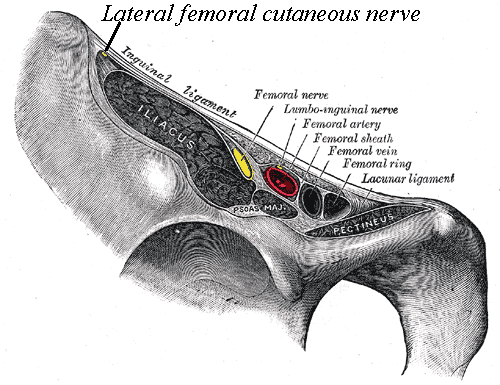Introduction to meralgia paresthetica:

The lateral femoral cutaneous nerve enters the thigh between the ASIS and the iliacus, deep to the sartorius and tensor fasciae latae.
Meralgia paresthetica is a condition in which the lateral femoral cutaneous nerve is compressed, causing pain or other altered sensation into the lateral thigh. The term “meralgia” literally means pain in the thigh; and the term “paresthesia” means altered sensation.
The lateral femoral cutaneous nerve is formed by the merging of the L2 and L3 nerve roots in the abdominal cavity between the psoas major and the quadratus lumborum. It exits the abdominopelvic cavity, passing deep to the inguinal ligament near the anterior superior iliac spine (ASIS) to enter the anterolateral thigh. As its name states, the lateral femoral cutaneous nerve provides sensory innervation to the skin of the lateral thigh. Therefore, compression of the nerve would cause altered sensation in that region of the body.
Causes:
Meralgia paresthetica is caused by compression to the lateral femoral cutaneous nerve, usually as it passes deep to the inguinal ligament. Compression most often occurs due to “external” pressure, often from a belt or waistband of pants pressing inward. Heavy belts such as those worn by police officers or carpenters, and tight pants, especially when worn low against the hips are especially prone to cause this condition. Being overweight also increases the risk for this condition because folds of abdominal fat can press against the inguinal ligament and proximal thigh. Prolonged sitting can be a problem because this position compresses the inguinal ligament. People who habitually stand in a posture of posterior tilt are also prone to develop this condition because it pushes the femoral head anteriorly, compressing the tissue at the anterior hip joint. Extension of the thigh, for example when walking, can also be problematic because it places a tension upon the inguinal ligament, pulling it taut against the contents deep to it.
In some individuals, the lateral femoral cutaneous nerve pierces through the inguinal ligament instead of passing deep to it, further increasing the likelihood of compression in individuals who have tension in the inguinal ligament. In other individuals, the nerve might even pierce through the sartorius muscle, increasing the likelihood of compression if the client’s/patient’s sartorius is tight. Due to its proximity, tightness in the tensor fasciae latae (TFL) or sartorius is also a likely contributor to this condition.
Meralgia paresthetica can also result from a direct physical trauma to the lateral femoral cutaneous nerve such as an injury due to a seat belt during a motor vehicle accident. Although not common, this condition can also occur due to neuropathy caused by disease such as diabetes. Other possible but less likely causes are cysts or tumors that press on the nerve in the abdominopelvic cavity, or perhaps pressure from a bony exostosis (bony protuberance) on the ASIS or brim of the pelvis against the nerve.



